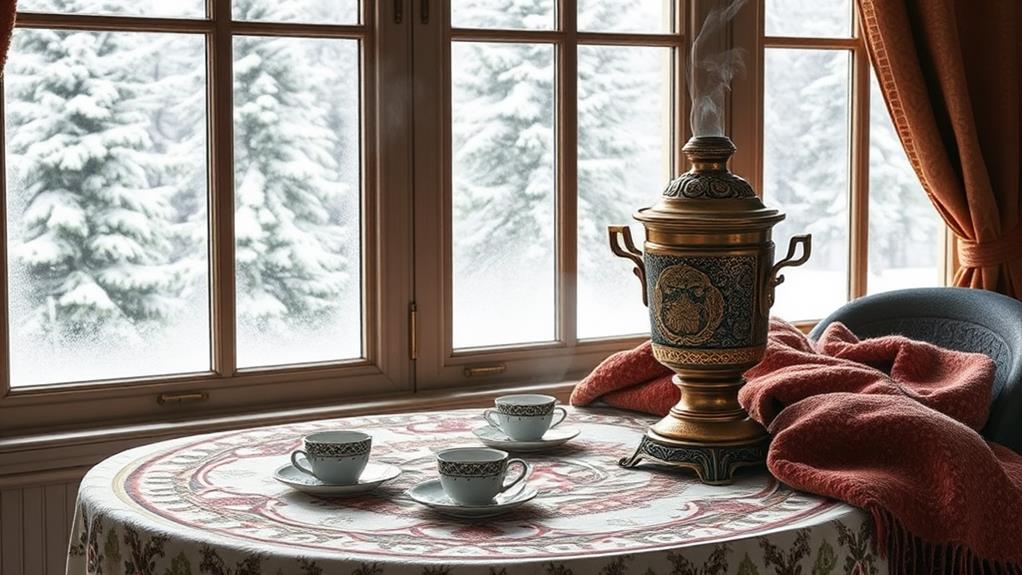In Russian tea culture, the samovar is more than just a kettle—it's a warm gathering place during chilly winters. Introduced in the 17th century, tea became a symbol of hospitality, inviting friends and family to share cozy moments. This traditional vessel brews rich, flavorful tea, often served with sweet and savory snacks like pirozhki and buttery blinis. As you sip your tea, you not only enjoy its comforting taste but also connect with those around you, strengthening bonds. Exploring different teas and snacks offers endless possibilities—stick around to uncover even more about this delightful tradition!
Historical Origins of Tea in Russia
Historically, tea has played a significant role in Russian culture since its introduction in the 17th century. This fascinating beverage journey began with Chinese influence, as traders brought tea along the Silk Road. You might imagine the bustling trade routes, where excitement mixed with the aroma of freshly brewed tea, creating a rich cultural exchange.
Russia's early adoption of tea was fueled by royal preferences, with the nobility embracing this exotic drink for its sophistication.
As tea made its way into Russian society, regional variations emerged, reflecting local tastes and traditions. You'll find that each area developed its own unique customs around tea drinking, making it a delightful experience that goes beyond just sipping.
In the heart of this transformation, tea became a symbol of hospitality and warmth, especially during cold winters.
The Role of the Samovar
When you think of Russian tea culture, the samovar is hard to miss. This unique kettle has a rich history and plays a vital role in brewing tea, hosting social gatherings, and creating cherished traditions.
Let's explore how this fascinating piece of equipment not only heats water but also brings people together around the table.
History of the Samovar
At the heart of Russian tea culture lies the samovar, a distinctive and essential piece of equipment that has shaped social gatherings for centuries. When you think of a samovar, you're not just picturing a metal kettle; you're seeing a symbol of warmth, hospitality, and togetherness. Its rich history showcases incredible samovar craftsmanship, with artisans creating unique designs that blend beauty and functionality.
Traditionally, the samovar wasn't just a tool for boiling water; it became a focal point for family and friends to gather around. Imagine sharing stories, laughter, and warmth during cold winters, all while brewing tea that warms both your hands and your heart. The samovar symbolizes more than just a beverage; it represents a cultural bond that brings people closer.
Over time, the samovar has evolved, integrating modern innovations while still honoring its historical roots. Today, it stands as a testament to Russian traditions, reminding us of the importance of connection and community.
Brewing Techniques and Traditions
While the samovar serves as a centerpiece for Russian tea culture, the brewing techniques and traditions associated with it are equally significant.
You'll find that using the right brewing equipment can truly enhance your tea experience. First, it's essential to choose high-quality tea leaves; they're the heart of a great brew. Regular consumption of tea can aid in preventing heart disease and support overall wellness, making your choice even more meaningful exceptional health benefits.
Start by filling the samovar with water and setting it to heat. The top part, called the teapot, is where you'll mix your concentrated tea. Traditionally, you'd brew a strong infusion by steeping tea leaves in just a small amount of boiling water. This creates a rich, flavorful syrup.
Once ready, you'll pour this concentrated tea into your cup and dilute it with hot water from the samovar below. This method not only ensures a perfect cup but also allows for personalization.
Want it stronger? Simply add more syrup. Prefer it milder? Add more hot water. Experimenting with different tea leaves can lead to exciting new flavors!
Social Gatherings and Rituals
There's something special about the role of the samovar in social gatherings and rituals within Russian culture. This iconic symbol not only brews tea but also brings people together, fostering social connections and strengthening friendship bonds.
In many ways, the samovar embodies the spirit of tea culture, reflecting values of hospitality and community found in various societies around the world, such as in traditional tea ceremonies. Whether you're at a family gathering or a seasonal celebration, the samovar serves as a centerpiece that sparks conversation and storytelling moments.
Here are four key aspects of the samovar's cultural significance:
- Tea Rituals: The act of brewing and serving tea becomes a cherished ritual, allowing for shared experiences and heartfelt discussions.
- Communal Gatherings: Friends and family gather around the samovar, creating a warm atmosphere that encourages laughter and connection.
- Family Traditions: Many families have their own ways of enjoying tea, passing down these traditions through generations, which enriches their cultural identity.
- Celebratory Moments: From birthdays to holidays, the samovar often plays a crucial role in seasonal celebrations, marking special occasions with its comforting presence.
In a world that can feel disconnected, the samovar reminds us of the joy found in coming together, celebrating life, and creating lasting memories over a warm cup of tea.
Traditional Brewing Techniques
In Russian tea culture, traditional brewing techniques play a vital role in creating the perfect cup. You'll find that the right brewing equipment is essential for achieving that rich flavor you crave.
A samovar, for example, isn't just a beautiful centerpiece; it serves as both a kettle and a teapot, providing a unique way to brew tea. This method of using a samovar is reminiscent of practices in other cultures where tea serves as a symbol of hospitality and community.
When it comes to infusion methods, you might want to explore the traditional way of using loose leaf tea. This method allows the leaves to expand and release their full flavor, creating a more aromatic experience. You'll often see black tea brewed strong, then diluted with hot water, catering to various taste preferences among guests.
Experimenting with different infusion times can also open up new flavor profiles. Just remember, patience is key; allowing the tea to steep for the right amount of time can transform your cup.
Popular Tea Varieties
When exploring Russian tea culture, you'll quickly discover that certain tea varieties stand out as favorites among enthusiasts. Each type brings its own unique flavor and character, creating a delightful experience for every tea lover.
Additionally, tea offers numerous health benefits, making it a great choice for both enjoyment and wellness. Here are four popular tea varieties you should try:
- Black Tea: This strong and robust tea is often enjoyed with a dash of sugar or lemon. It's perfect for cold winter days when you need a warm boost and provides benefits such as improved gut health and cognitive function.
- Green Tea: Known for its health benefits, green tea offers a lighter taste and is often enjoyed plain or with subtle flavors. It's refreshing and invigorating, with properties that aid in weight loss and boost metabolism promoting overall health.
- Herbal Infusions: These caffeine-free blends can include anything from chamomile to mint, providing soothing and aromatic experiences that are perfect for relaxation.
- Chai Varieties: Russian chai blends often incorporate spices and flavored teas, creating a rich, warming drink that pairs beautifully with sweet treats.
With loose leaf options, specialty teas, and innovative tea blends, there's no shortage of choices to explore.
Accompaniments and Snacks
Pairing tea with the right snacks can elevate your Russian tea experience to a new level. Imagine sipping a warm cup of fragrant tea while nibbling on delightful accompaniments that complement each sip. You might want to explore various tea pairings that bring out the unique flavors in each beverage.
For instance, buttery blinis topped with smoked salmon are a match made in heaven with a rich black tea.
Don't forget about sweet options, either! Try traditional Russian pastries like pirozhki, filled with jam or berries, which bring a touch of sweetness to your tea time. For a crunchier bite, seek out kvass-flavored crackers or rye bread topped with cheese. These snack options not only satisfy your cravings but also add a cultural twist to your tea ritual.
Experimenting with different combinations can lead to delightful discoveries. Who knows? You might find that a spiced chai pairs perfectly with a slice of honey cake, creating a symphony of flavors.
Social Customs and Etiquette
When you step into a Russian home for tea, you'll quickly notice that hospitality is a big deal.
The traditional tea ceremony isn't just about the drink; it's a warm invitation to connect and share stories, often accompanied by delicious treats.
Understanding these customs will make your experience richer and more enjoyable, so let's explore what you can expect!
Traditional Tea Ceremony
The Russian tea ceremony is a rich blend of tradition and hospitality, showcasing the importance of social connections. When you participate in this ceremony, you'll discover the deep tea symbolism and cultural significance that permeate every moment.
It's not just about sipping tea; it's about fostering relationships and sharing stories.
Here are four key elements of the traditional tea ceremony:
- Samovar: The centerpiece of the ceremony, it symbolizes warmth and community.
- Tea Selection: Different types of tea represent various cultural backgrounds and personal preferences.
- Accompaniments: Sweet and savory treats, like pastries and jams, enhance the experience and promote sharing.
- Conversation: Engaging in meaningful dialogue is essential, as it strengthens bonds and creates lasting memories.
As you navigate through this unique experience, remember that every cup of tea serves as a bridge between past and present.
Embrace the communal spirit, and you'll find that the Russian tea ceremony is more than just a ritual; it's an innovative way to connect with others, fostering an atmosphere of warmth and friendship in cold winters.
Guest Hospitality Practices
In the heart of Russian culture, guest hospitality practices hold a place of great significance, reflecting a deep-rooted tradition of warmth and generosity. When you visit a Russian home, expect a delightful experience filled with genuine guest interaction. From the moment you step inside, you'll notice the welcoming atmosphere, often enhanced by the presence of a samovar bubbling with tea.
Hospitality etiquette in Russia is all about making guests feel special. You might be offered a spread of delicious treats, from homemade pies to savory snacks, all meant to showcase the host's care. It's common to hear phrases like "На здоровье!" (To your health!) as toasts are made, adding a festive spirit to the gathering.
As a guest, you'll want to express gratitude for the hospitality. Complimenting the food and drinks is always appreciated, and engaging in light conversation helps build a connection.
Modern Adaptations of Tea Culture
How has Russian tea culture evolved in today's fast-paced world? You might be surprised by the innovative twists on traditional practices. As life accelerates, tea culture adapts, embracing new trends that cater to modern tastes. Here are some exciting developments you'll want to explore:
- Flavored Teas: Think beyond basic blends! Flavored teas now include everything from fruity to spicy infusions, appealing to adventurous palates. The art of combining various tea types and herbs leads to endless possibilities for exciting taste sensations.
- Tea Cocktails: Imagine sipping on a refreshing tea cocktail! These drinks combine the elegance of tea with the buzz of mixology, perfect for social gatherings.
- Herbal Infusions: Herbal teas are gaining popularity, offering health benefits while delivering unique flavors. They're a great way to unwind after a long day.
- Modern Teahouses: Today's teahouses are vibrant spaces that host tea events, encouraging community and creativity through tea pairings and tastings.
With these modern adaptations, Russian tea culture remains relevant, inviting you to experience its rich history while enjoying innovative flavors.
Regional Variations in Tea Practices
Diving into the rich tapestry of Russian tea culture reveals a fascinating array of regional variations that shape how tea is enjoyed across the country.
In Siberia, for instance, you'll find unique Siberian blends that often mix black tea with wild herbs and berries, creating a bold and invigorating flavor. These blends reflect the natural bounty of the region and are perfect for warming up during those chilly winters.
Traveling to the Caucasus, the tea experience shifts dramatically. Here, you'll encounter the use of local Caucasian herbs, which add aromatic notes that tantalize the senses. This region's tea culture often embraces a more communal approach, with gatherings centered around sharing stories and laughter.
As you venture into the Russian Far East, you'll find influences from neighboring countries. Green tea is popular here, often infused with tropical fruits, creating a refreshing contrast to the traditional black teas.
And in urban centers, modern tea culture thrives, with trendy tea houses offering innovative blends and creative presentations that cater to the adventurous spirit of city dwellers.
Each region's tea practices offer a delightful glimpse into Russia's diverse cultural landscape, making every cup a unique experience.
The Health Benefits of Tea
Tea offers a treasure trove of health benefits that can enhance your well-being. Sipping on your favorite brew doesn't just warm your hands; it fuels your body and mind, too!
Let's dive into some of the fantastic perks you can enjoy:
- Antioxidant properties: Tea is packed with antioxidants, which help combat free radicals and reduce oxidative stress in your body. This means you'll feel healthier overall!
- Mental clarity: Need a brain boost? The caffeine and L-theanine combo in tea improves focus and mental clarity, helping you tackle that homework or creative project with ease.
- Hydration: Contrary to popular belief, tea contributes to your daily hydration needs, keeping you refreshed and energized.
- Relaxation: Certain teas, like chamomile and lavender, promote relaxation and can help reduce stress, making your tea time a mini retreat.
FAQ
What Are the Best Types of Tea for Cold Weather?
For cold weather, you'll love bold black tea varieties and spicy chai. Herbal blends like hibiscus or chai-infused blends warm you up, too. Experiment with flavors to create innovative, cozy brews that brighten chilly days!
How Has Globalization Influenced Russian Tea Culture?
Globalization's transformed Russian tea culture through enhanced tea trade and cultural exchange. You'll discover diverse flavors and practices, blending traditional Russian customs with innovative global influences, enriching your tea experience and broadening your appreciation for this beloved beverage.
Are There Specific Tea Ceremonies in Russia?
Yes, you'll find that Russian tea traditions often include ceremonial practices like the "zavarka" method. By blending strong tea with hot water, you create a unique experience, blending innovation with rich cultural heritage. Enjoy exploring these rituals!
What Unique Tea-Infused Desserts Are Popular in Russia?
In Russia, you'll love indulging in unique tea-infused desserts like fragrant tea cakes and flavorful tea jams. These innovative treats blend tradition with creativity, offering delightful experiences that elevate your tea time to new heights.
How Do Russians Typically Serve Tea at Home?
When you prepare tea, think of a warm embrace—steeping leaves in a samovar. Russians typically serve it with sugar, jam, or lemon, creating a delightful ritual that dances on your taste buds and warms your spirit.
Final Thoughts
In essence, Russian tea culture is a heartwarming blend of tradition and community, where every sip tells a story. From the iconic samovar to the delightful snacks that accompany your brew, it's a rich experience that warms you from the inside out. So, whether you're huddled by the fire or sharing laughter with friends, remember that a cup of tea isn't just a drink—it's a bridge connecting hearts and cultures. Cheers to that!



